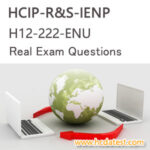Exam Code: H12-261-ENU
Exam Name: (Written)(Huawei Certified Internetwork Expert-Routing & Switching)
Available Language: English, Chinese
Register: Pearson VUE
Exam Fee: 300 USD
In this blog, we share the latest real H12-261-ENU online test which reflect the actual exam.
H12-261 HCIE-R&S Exam Exam Outline
2.1 Layer 2 Technologies
2.1.1 STP
1.STP
2.RSTP
3.MSTP
4.Loop guard
5.Root guard
6.BPDU guard
7.TC-BPDU attack guard
2.1.2 VLAN and GVRP
1.Access port
2.Trunk port
3.Hybrid port
4.QinQ
5.Vlan Aggregation
6.Mux Vlan
7.Voice vlan
8.GARP
9.GVRP
2.1.3 Transparent bridge
1.Local Bridging
2.Remote Bridging
3.Integrated Bridging and Routing
4.VLAN ID Transparent Transmission
2.1.4 Link Aggregation, Eth-Trunk and IP-Trunk, Load-balance, LACP
1.Link Aggregation
2.LACP
2.1.5 Ethernet technologies
1.Speed and duplex
2.Ethernet, Fast Ethernet, and Gigabit Ethernet
3.Auto MDI/MDIX
4.Auto negotiation
5.Storm control
6.Unicast flooding control
2.1.6 HVRP
2.1.7 Smart link
2.1.8 DLDP
2.1.9 Switched Port Analyzer (port-mirroring)
2.1.10 Frame Relay
1.LMI
2.Traffic shaping
3.Full mesh
4.Hub and spoke
5.DE
2.1.11 HDLC and PPP
2.1.12 PPPoE and PPPoA
2.2 IPv4
2.2.1 IPv4 addressing, subnetting, and VLSM
2.2.2 IPv4 tunneling and GRE
2.2.3 IPv4 RIP version 1/2
2.2.4 IPv4 OSPF
1.Standard OSPF areas
2.Stub area
3.Totally stubby area
4.NSSA
5.Totally NSSA
6.LSA types
7.Adjacency on a point-to-point and on a multi-access network
8.Virtual-Link
9.LSA Filter
10.OSPF graceful restart
11.Stub Router
12.OSPF Authentication
2.2.5 IPv4 IS-IS
1.NSAP
2.IS-IS Link-state packets
3.IS-IS area type
4.IS-IS circuit type
5.IS-IS TLV
6.IS-IS DIS and Pseudo node
7.IS-IS SPF
8.IS-IS LSP
9.IS-IS Metric
10.IS-IS Route Leaking
11.IS-IS RPC
12.IS-IS Graceful Restart
13.IS-IS LDP Synchronization
14.IS-IS Authentication
2.2.6 IPv4 BGP
1.IBGP and EBGP
2.BGP attributes
3.BGP synchronization
4.BGP routes Summarization
5.Route Dampening
6.BGP route reflector
7.BGP confederation
8.BGP Community
9.BGP Peer Groups
10.BGP Graceful Restart
11.BGP Security
12.Principles of Route Selection
2.2.7 Route Control
1.Filtering
2.IP Prefix list
3.Route Import(redistribution)
4.Route policy
5.Summarization
6.Preference
7.Other advanced features
2.3 IPv6
2.3.1 IP version 6 addressing and different addressing types
2.3.2 IPv6 neighbor discovery
2.3.3 IPv6 functionality protocols
2.3.4 Tunneling techniques
2.3.5 RIPng
2.3.6 OSPF version 3
2.3.7 MP BGP
2.3.8 Route Control
2.4 MPLS VPN
2.4.1 MPLS
1.MPLS network component (P, PE, CE)
2.MPLS label format
3.MPLS label encapsulation
4.MPLS label stack
5.MPLS label operation
6.Forwarding Equivalence Class
7.LDP
8.Label advisement model
9.MPLS LDP—Local Label Allocation Filtering
10.MPLS LDP Inbound/outbound Label Binding Filtering
2.4.2 MPLS Layer 3 VPN
1.MP-IBGP VPNv4 peering
2.VPN-instance
3.Route Distinguisher
4.Route Target
5.Route Target import/export
6.PE-CE–Dynamic Routes
7.PE-CE–Static Routes
8.Redistributing PE-CE routes into VPNv4
9.Redistributing VPN4 routes into PE-CE routing table
10.MPLS VPN Multicast
11.MCE
2.5 IP Multicast
2.5.1 Multicast distribution tree
2.5.2 Multicast forwarding
2.5.3 Multicast RPF
2.5.4 Multicast Administrative Boundaries
2.5.5 PIM dense mode
2.5.6 PIM sparse mode
2.5.7 IGMP
2.5.8 IGMP Snooping
2.5.9 MSDP
2.5.10 Inter domain multicast routing
2.5.11 PIM RP, and BSR
2.5.12 Multicast tools, features, and source-specific multicast
2.6 Network Security
2.6.1 Access lists
2.6.2 uRPF
2.6.3 IP Source Guard
2.6.4 AAA
2.6.5 802.1x / NAC
2.6.6 NAT
1.Static NAT/NAPT
2.Dynamic NAT/PAT
3.Easy IP
4.NAT Server
5.Twice NAT
6.ALG
7.NAT Mapping
8.NAT Filtering
2.6.7 Device access control
2.6.8 Security features
2.6.9 Traffic Suppression
2.6.10 Local Attack Defense
2.6.11 IP Address Anti-spoofing
2.6.12 ARP Security
2.6.13 DHCP Security
2.7 QoS
2.7.1 QoS
1.PQ、DRR、PQ+DRR、WRR、PQ+WRR、WFQ and PQ+WFQ
2.Classification
3.Traffic Policing
4.Traffic Shaping
5.Marking
6.WRED and RED
7.Compression
8.HQoS
9.Class-based QoS
2.7.2 Fragmentation for Frame Relay
2.7.3 CBS、CIR、TC、BC for Frame Relay
2.7.4 Generic traffic shaping
2.7.5 RSVP
2.8 Troubleshoot a Network
1.Troubleshoot complex Layer 2 network issues
2.Troubleshoot complex Layer 3 network issues
3.Troubleshoot a network in response to application problems
4.Troubleshoot network services
5.Troubleshoot network security
2.9 Network Management
1.Syslog
2.IP Service Level Agreement SLA
3.NetStream
4.NQA
5.SNMP
6.FTP
7.Telnet
8.SSH
2.10 Feature
1.VRRP
2.VGMP
3.Interface Backup
4.NTP
5.DHCP
6.BFD
All the questions in our full version are highly covered in your real exam. You will know it clearly when you take your exam.








Reviews
There are no reviews yet.